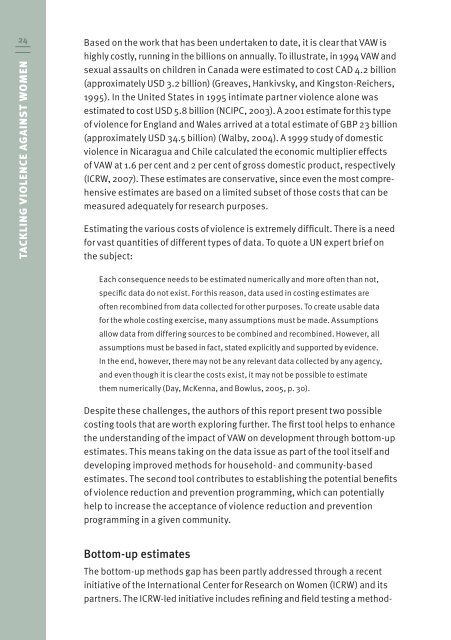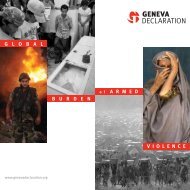Tackling Violence against Women: From Knowledge to Practical
Tackling Violence against Women: From Knowledge to Practical
Tackling Violence against Women: From Knowledge to Practical
You also want an ePaper? Increase the reach of your titles
YUMPU automatically turns print PDFs into web optimized ePapers that Google loves.
24 Based on the work that has been undertaken <strong>to</strong> date, it is clear that VAw is<br />
highly costly, running in the billions on annually. To illustrate, in 1994 VAw and<br />
sexual assaults on children in Canada were estimated <strong>to</strong> cost CAD 4.2 billion<br />
(approximately USD 3.2 billion) (greaves, Hankivsky, and kings<strong>to</strong>n-Reichers,<br />
1995). In the United States in 1995 intimate partner violence alone was<br />
estimated <strong>to</strong> cost USD 5.8 billion (NCIpC, 2003). A 2001 estimate for this type<br />
of violence for England and wales arrived at a <strong>to</strong>tal estimate of gBp 23 billion<br />
(approximately USD 34.5 billion) (walby, 2004). A 1999 study of domestic<br />
violence in Nicaragua and Chile calculated the economic multiplier effects<br />
of VAw at 1.6 per cent and 2 per cent of gross domestic product, respectively<br />
(ICRw, 2007). These estimates are conservative, since even the most comprehensive<br />
estimates are based on a limited subset of those costs that can be<br />
measured adequately for research purposes.<br />
TAckliNG ViolENcE AGAiNsT WomEN<br />
Estimating the various costs of violence is extremely difficult. There is a need<br />
for vast quantities of different types of data. To quote a UN expert brief on<br />
the subject:<br />
Each consequence needs <strong>to</strong> be estimated numerically and more often than not,<br />
specific data do not exist. For this reason, data used in costing estimates are<br />
often recombined from data collected for other purposes. To create usable data<br />
for the whole costing exercise, many assumptions must be made. Assumptions<br />
allow data from differing sources <strong>to</strong> be combined and recombined. However, all<br />
assumptions must be based in fact, stated explicitly and supported by evidence.<br />
In the end, however, there may not be any relevant data collected by any agency,<br />
and even though it is clear the costs exist, it may not be possible <strong>to</strong> estimate<br />
them numerically (Day, Mckenna, and Bowlus, 2005, p. 30).<br />
Despite these challenges, the authors of this report present two possible<br />
costing <strong>to</strong>ols that are worth exploring further. The first <strong>to</strong>ol helps <strong>to</strong> enhance<br />
the understanding of the impact of VAw on development through bot<strong>to</strong>m-up<br />
estimates. This means taking on the data issue as part of the <strong>to</strong>ol itself and<br />
developing improved methods for household- and community-based<br />
estimates. The second <strong>to</strong>ol contributes <strong>to</strong> establishing the potential benefits<br />
of violence reduction and prevention programming, which can potentially<br />
help <strong>to</strong> increase the acceptance of violence reduction and prevention<br />
programming in a given community.<br />
Bot<strong>to</strong>m-up estimates<br />
The bot<strong>to</strong>m-up methods gap has been partly addressed through a recent<br />
initiative of the International Center for Research on women (ICRw) and its<br />
partners. The ICRw-led initiative includes refining and field testing a method-









